Oldsmobile Cutlass Supreme 1993 Owner's Manuals
Manufacturer: OLDSMOBILE, Model Year: 1993, Model line: Cutlass Supreme, Model: Oldsmobile Cutlass Supreme 1993Pages: 340, PDF Size: 16.21 MB
Page 141 of 340

Part 4
Here you’ll find information about driving on different kinds of roads and
in varying weather conditions
. We’ve
also included many other useful tips
on driving
.
Your Driving and the Road
Road Signs ........................................................................\
....................................... 140
Defensive Driving
........................................................................\
............................ 144
Drunken Driving
........................................................................\
............................ 145
Control of a Vehicle
Braking
........................................................................\
......................................... 148
Anti-Lock Brakes ........................................................................\
......................... 149
Steering Tips
........................................................................\
................................ 154
Steering in Emergencies
........................................................................\
.............. 155
Driving at Night
........................................................................\
............................... 159
Driving in the Rain
........................................................................\
.......................... 161
Passing ........................................................................\
......................................... 156
Driving in Fog, Mist and Haze
........................................................................\
....... 164
City Drmng
........................................................................\
...................................... 165 ..
Freeway Driving ........................................................................\
............................. 166
Driving a Long Distance ........................................................................\
................ 168
Hill and Mountain Roads ........................................................................\
............... 170
Winter Driving
........................................................................\
................................ 173
Parking
on Hills ........................................................................\
.............................. 171
Towing a Trailer
........................................................................\
............................... 176 139
Page 142 of 340
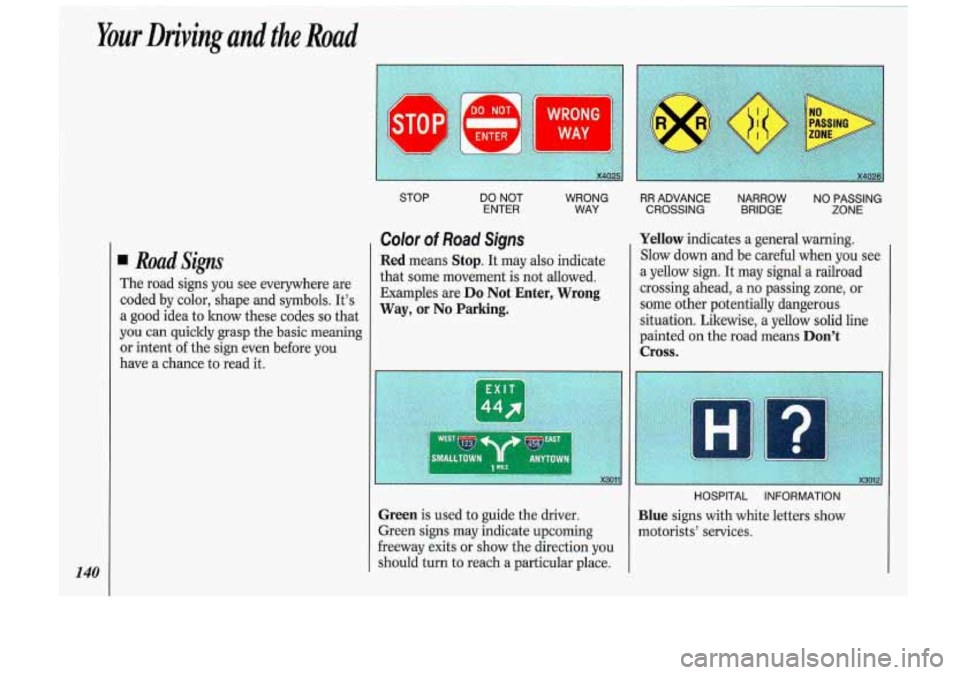
Your Driving and the Road
~
140
Road Signs
The road signs you see everywhere are
coded by color, shape and symbols. It's
a good idea to lmow these codes so that
you can quickly grasp the basic meaning
or intent of the sign even before you
have a chance to read it.
STOP
DO NOT
ENTER WRONG
WAY
Color of Road Signs
Red means Stop. It may also indicate
that some movement is not allowed.
Examples are
Do Not Enter, Wrong
Way,
or No Parking.
Green is used to guide the driver.
Green signs may indicate upcoming
freeway exits or show the direction you
should turn to reach a particular place.
RR ADVANCE NARROW NO PASSING
CROSSING BRIDGE ZONE
Yellow indicates a general warning.
Slow down and be careful when you see
a yellow sign. It may signal a railroad
crossing ahead, a no passing zone, or
some other potentially dangerous
situation. Likewise, a yellow solid line
painted on the road means
Don't
Cross.
Blue signs with white letters show
motorists' services.
Page 143 of 340
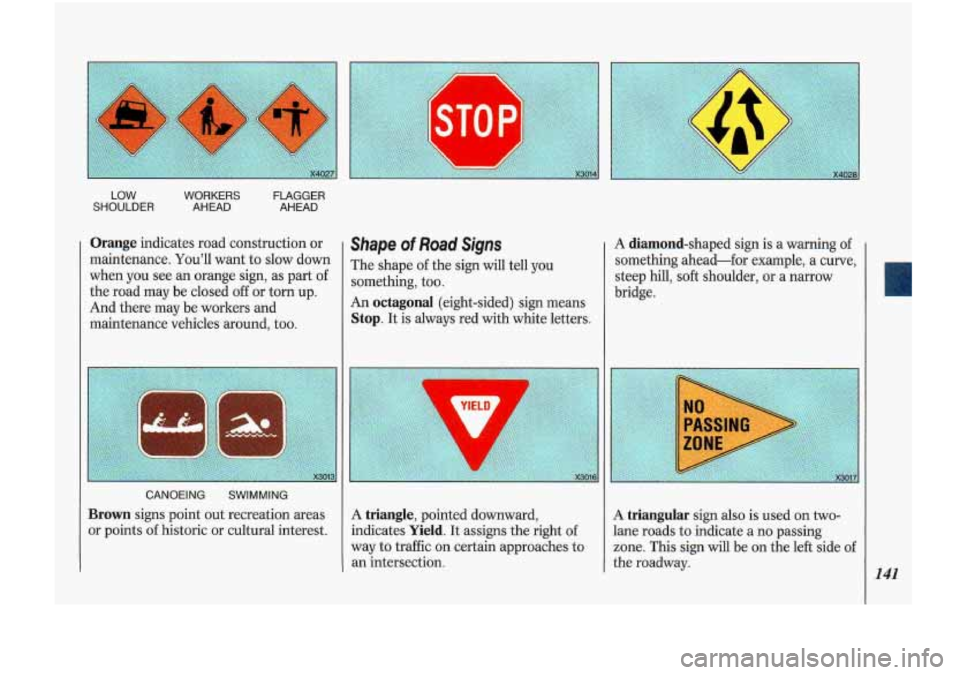
LOW WORKERS FLAGGER
SHOULDER AHEAD AHEAD
Orange indicates road construction or
maintenance. You’ll want to slow down
when you see
an orange sign, as part of
the road may be closed
off or torn up.
And there may be workers and
maintenance vehicles around, too.
II
II
Shape of Road Signs
The shape of the sign will tell you
something, too.
An octagonal (eight-sided) sign means
Stop. It is always red with white letters.
CAtuuttt\lG SWIMMING
3rown signs point out recreation areas
)r points of historic or cultural interest.
4 diamond-shaped sign is a warning of
something ahead-for example, a curve,
steep hill,
soft shoulder, or a narrow
xidge.
A triangle, pointed downward,
indicates Yield.
It assigns the right of
way to traffic on certain approaches to
an intersection.
1 triangular sign also is used on two-
ane roads to indicate
a no passing
!one. This sign will be on the left side of
:he roadway.
141
Page 144 of 340
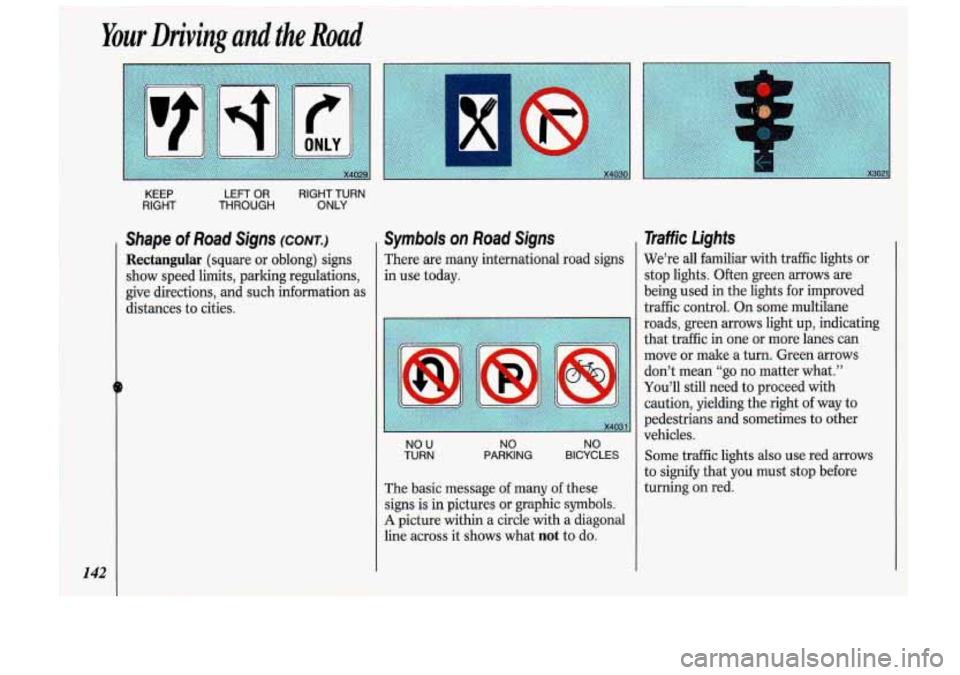
142
KEEP LEFl “,3 RIGHTTURN
RIGHT THROUGH ONLY
Shape of Road Signs (CONT.)
Rectangular (square or
oblong) signs
show speed limits, parking regulations,
give directions, and such information as
distances to cities.
Symbols on Road Signs
There are many international road signs
in use today.
NO U TURN NO NO PARKING BICYCLES
The basic message
of many of these
signs
is in pictures or graphic symb01~.
A picture within a circle with a diagonal
line across it shows what
not to do.
Traffic Dghts
We’re all familiar with traffic lights or
stop lights. Often green arrows are
being used in the lights for improved
traffic control. On some multilane
roads, green arrows light up, indicating
that traffic in one or more lanes can
move or make a turn. Green arrows
don’t mean “go no matter what.”
You’ll still need to proceed with
caution, yielding the right of way to
pedestrians and sometimes to other
vehicles.
Some traffic lights also use red arrows
to signify that
you must stop before
turning
on red.
Page 145 of 340

REW%SI!BLE IANE ON MULTlIANiE ROADWAY N'O PASSING' ZONE.
I
i
Page 146 of 340
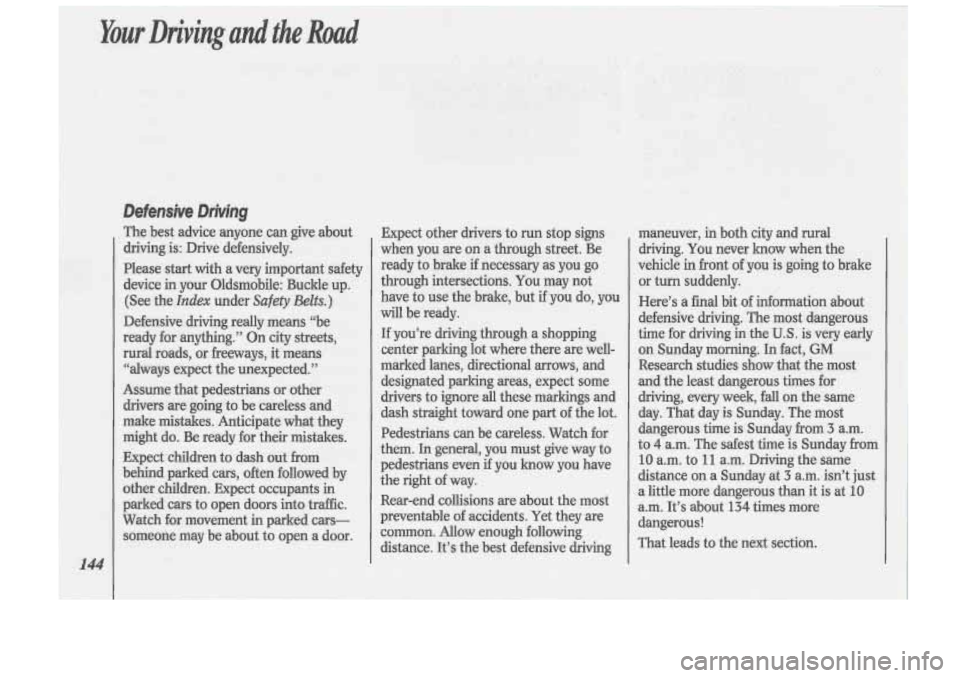
Your Driving and the Road
Defensive Driving
, The best advice anyone can give about
144
driving is: Drive defensively.
Please start with a very important safety
device in your Oldsmobile: Buckle up.
(See the
Index under Safety Belts. )
Defensive driving really means “be
ready for anything.”
On city streets,
rural roads, or freeways, it means
“always expect the unexpected.’’
Assume that pedestrians or other
drivers are going to be careless and
make mistakes. Anticipate what they
might do. Be ready for their mistakes.
Expect children to dash out from
behind parked cars, often followed by
other children. Expect occupants in
parked cars to open doors into traffic.
Watch for movement in parked cars-
someone may be about to open a door. Expect
other drivers
t .o run st ,op signs
when you are on a through street. Be
ready to brake if necessary as you go
through intersections.
You may not
have to use the brake, but if you do, you
will be ready.
If you’re driving through a shopping
center parking lot where there are well-
marked lanes, directional arrows, and
designated parking areas, expect some
drivers to ignore all these markings and
dash straight toward one part
of the lot.
Pedestrians can be careless. Watch for
them. In general, you must give way to
pedestrians even if you know you have
the right of way.
Rear-end collisions are about the most
preventable of accidents. Yet they are
common. Allow enough following
distance. It’s the best defensive driving maneuver,
in both city and rural
driving. You never know when the
vehicle in front of you is going to brake
or turn suddenly.
Here’s a final bit of information about
defensive driving. The most dangerous
time for driving in the
U.S. is very early
on Sunday morning. In fact, GM
Research studies show that the most
and the least dangerous times for
driving, every week, fall
on the same
day. That day is Sunday. The most
dangerous time is Sunday from
3 a.m.
to
4 a.m. The safest time is Sunday from
10 a.m. to 11 a.m. Driving the same
distance
on a Sunday at 3 a.m. isn’t just
a little more dangerous than it is at
10
a.m. It’s about 134 times more
dangerous!
That leads to the next section.
Page 147 of 340
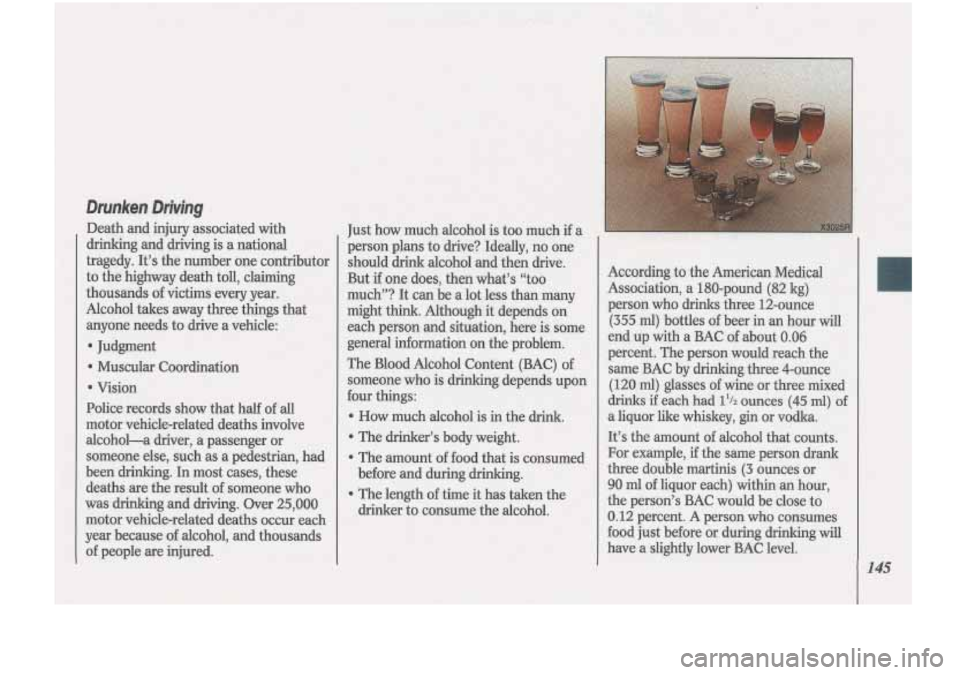
!. !'
Page 148 of 340
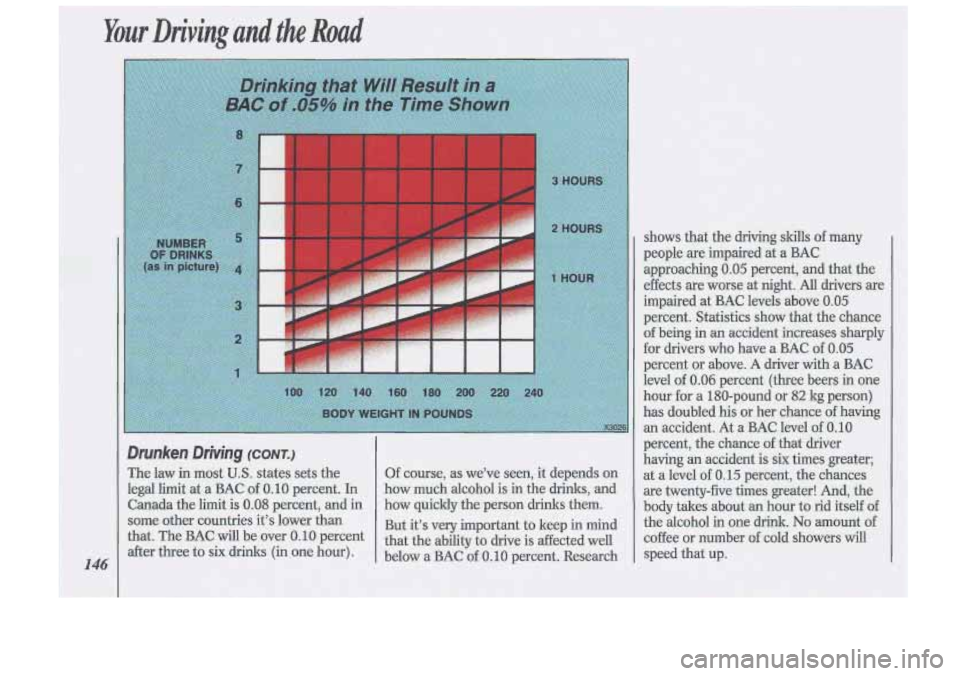
! I Your Driving and the Road
Drunken Driving (CONT.)
The law in most US. states sets the
legal limit at a BAC of
0.10 percent. In
Canada the limit is
0.08 percent, and in
some other countries it’s lower than
that. The BAC will be over
0.10 percent
after three to six drinks (in one hour).
c-
Of course, as we’ve seen, it depends on
how much alcohol is in the drinks, and
how quicMy the person drinks them.
But it’s very important to keep in mind
that the ability to drive is affected well
below a BAC of
0.10 percent. Research shows
that the driving skills of many
people are impaired at a BAC
approaching
0.05 percent, and that the
effects are worse at night. All drivers
are
impaired at BAC levels above 0.05
percent. Statistics show that the chance
of being in an accident increases sharply
for drivers who have a BAC of
0.05
percent or above. A driver with a BAC
level of
0.06 percent (three beers in one
hour for
a 180-pound or 82 kg person)
has doubled his or her chance of having
an accident. At a BAC level
of 0.10
percent, the chance of that driver
having an accident is
six times greater;
at a level of 0.15 percent, the chances
are twenty-five times greater! And, the
body takes about an hour to rid itself of
the alcohol in one drink.
No amount of
coffee or number of cold showers will
speed that up.
Page 149 of 340

I
Drinking and then driving is
L very dangerous. Your
reflexes, perceptions, and judgment
can be affected by even
a small
amount
of alcohol. You could have
a serious-or even fatal-accident
if you drive after drinking. Please
don't drink and drive or ride with a
driver who has been drinking. Ride
home in
a cab; or if you're with a
group, designate a driver who will
not drink.
-
Page 150 of 340

Tiding” your brakes can
cause them to overheat to the
point that they won’t work well.
You might not be able to stop your
vehicle in time
to avoid an accident.
If you “ride” your brakes, they will
get
so hot they will require a lot of
pedal force to slow you down.
Avoid “riding” the brakes.